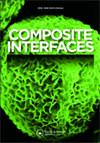Enhanced interfacial interaction, mechanical properties and thermal stability of basalt fiber/epoxy composites with multi-scale reinforcements
IF 2.4
4区 材料科学
Q3 MATERIALS SCIENCE, COMPOSITES
引用次数: 3
Abstract
ABSTRACT In this work, epoxy (EP) resin composites with multi-scale reinforcements were prepared by hand lay-up and hot-pressing. The epoxy was reinforced with basalt fibers (BF) modified with a silane coupling agent (KH560). Carboxylated multi-walled carbon nanotubes (CNTs) were also grafted onto the surface of the modified BF using an impregnation method to achieve BF/CNTs multi-scale reinforcement. Fourier transform infrared spectroscopy (FTIR) and X-ray photoelectron spectroscopy (XPS) showed that KH560 was successfully grafted onto the BF surface. Scanning electron microscopy (SEM), indicated a better resin adhesion on the BF and thus a stronger interfacial interaction in the BF/CNTs-reinforced composite. It was observed that the mass fraction of KH560 was a significant parameter in achieving desirable CNT immobilization and mechanical properties of the composites. At an optimal mass fraction of KH560 (5%), the tensile, flexural, and interlaminar shear strength (ILSS) of the modified composite (BF-5%KH560-CNT/EP) increased by 12.5%, 20.9%, and 25.5% respectively compared with the BF-washed/EP composite due to more efficient load transfer. In addition, compared with BF-washed/EP, the decomposition onset temperature of BF-5%KH560-CNT/EP increased from 387°C to 396°C, the maximum decomposition rate temperature increased from 400°C to 408°C, and the residual weight increased by 5.8%. GRAPHICAL ABSTRACT多尺度增强玄武岩纤维/环氧复合材料的界面相互作用、力学性能和热稳定性
本文章由计算机程序翻译,如有差异,请以英文原文为准。
求助全文
约1分钟内获得全文
求助全文
来源期刊

Composite Interfaces
工程技术-材料科学:复合
CiteScore
5.00
自引率
3.80%
发文量
58
审稿时长
3 months
期刊介绍:
Composite Interfaces publishes interdisciplinary scientific and engineering research articles on composite interfaces/interphases and their related phenomena. Presenting new concepts for the fundamental understanding of composite interface study, the journal balances interest in chemistry, physical properties, mechanical properties, molecular structures, characterization techniques and theories.
Composite Interfaces covers a wide range of topics including - but not restricted to:
-surface treatment of reinforcing fibers and fillers-
effect of interface structure on mechanical properties, physical properties, curing and rheology-
coupling agents-
synthesis of matrices designed to promote adhesion-
molecular and atomic characterization of interfaces-
interfacial morphology-
dynamic mechanical study of interphases-
interfacial compatibilization-
adsorption-
tribology-
composites with organic, inorganic and metallic materials-
composites applied to aerospace, automotive, appliances, electronics, construction, marine, optical and biomedical fields
 求助内容:
求助内容: 应助结果提醒方式:
应助结果提醒方式:


